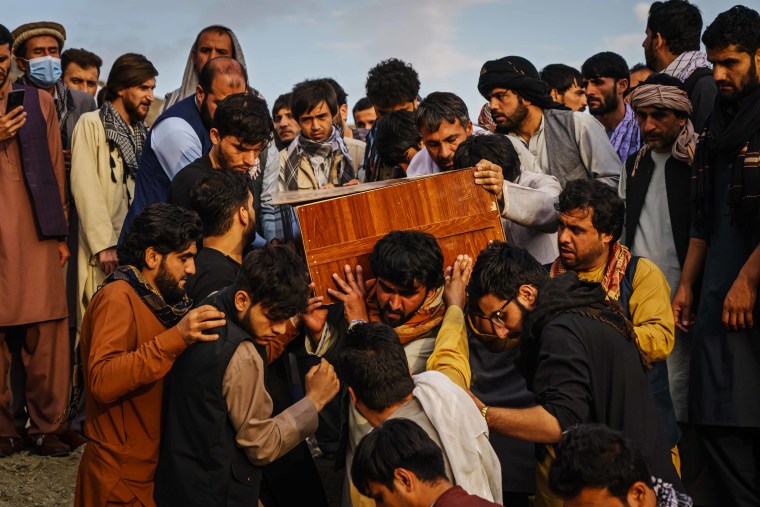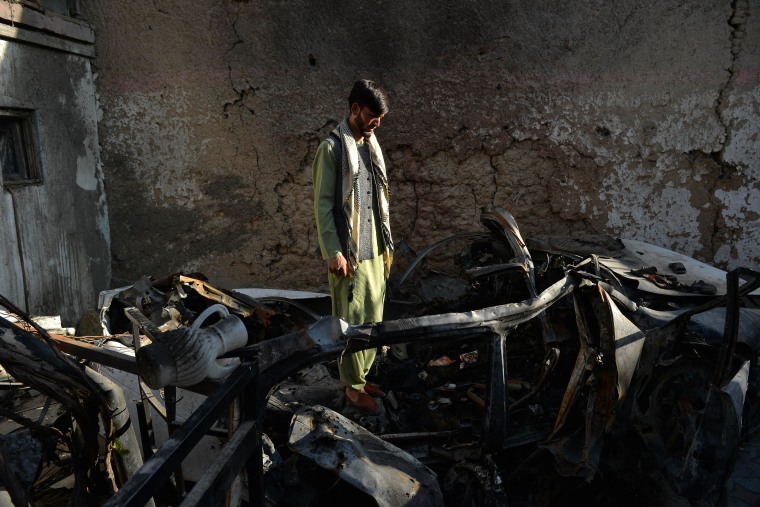More than a year after a mistaken U.S. drone strike killed Afghan aid worker Zemari Ahmadi and nine members of his family, just a handful of his relatives and colleagues have been relocated to the U.S., says an attorney for the nonprofit group that employed Ahmadi.
In the year since the tragic strike, the Defense Department and the Biden administration have vowed numerous times to compensate the family and help any family members wishing to leave Afghanistan and resettle in the U.S.
Brett Max Kaufman, an attorney for the American Civil Liberties Union who represents Nutrition & Education International of California, or NEI, which employed Ahmadi for 15 years, said 11 Afghans have made it to the U.S. out of a total of 144 family members and colleagues who have been trying to leave since the deadly strike on Aug. 29, 2021. Roughly 100 are relatives of Ahmadi’s, while the rest are other employees of NEI and their families, Kaufman said.
More than 100 of the aid workers and their families have been able to flee Afghanistan, Kaufman said, which two U.S. defense officials confirmed. About 40 are in Albania, and others have gone to Kosovo and Qatar, but they are all awaiting movement to the U.S. Thirty-two Afghans in the group have been unable to escape the country, the officials said.

Some of the Afghans made it out on charter flights to transit countries, but those require passports and documentation, which limits who can fly. At least one group escaped by driving out through Pakistan, but a second group that tried the same route was turned back at the border, Kaufman said.
A State Department spokesperson declined to offer precise numbers as to how many of the relatives have made it out of Afghanistan but said that “about 80 percent of the family members” have been relocated.
“We’re working to support the remaining family members who wish to relocate,” the spokesperson told NBC News.
A spokesperson for the Pentagon declined to provide specifics about the case, saying in a statement: “The Department of Defense, in coordination with other U.S. Government departments and agencies continue to take steps to respond to the August 29, 2021 airstrike in Kabul, Afghanistan. To protect the privacy of the family members, as well as to help protect their safety and security, we are not able to provide more information regarding these efforts at this time.”
The defense officials could not say whether any family members have received the condolence payments the Biden administration promised.
'I am fully responsible'
The drone strike came three days after a suicide bomb attack by Islamic State Khorasan, or ISIS-K, the militant group’s Afghan affiliate, killed 13 U.S. service members and more than 100 Afghan civilians at Kabul’s airport. Tensions were high as the U.S. military braced for another attack after U.S. intelligence warned that ISIS-K was plotting to hit the airport again, this time using a white Toyota Corolla.
The U.S. military initially defended the strike. On Sept. 1, 2021, the chairman of the Joint Chiefs of Staff, Gen. Mark Milley, said the strike killed at least one ISIS facilitator, and he pointed to “secondary explosions” as evidence that explosives were in the vehicle. He said procedures were followed, and he called it “a righteous strike.”

Later that month, the commander of U.S. Central Command at the time said further review showed that the strike actually killed civilians and that it was “a mistake.”
“This strike was taken in the earnest belief that it would prevent an imminent threat to our forces and the evacuees at the airport, but it was a mistake,” Marine Gen. Frank McKenzie said. “As the combatant commander, I am fully responsible for this strike and its tragic outcome.”
A Pentagon review later found that U.S. military surveillance may have misinterpreted information, with the water canisters Ahmadi loaded and unloaded in his Corolla being mistaken for explosives. Ahmadi’s vehicle was spotted by the U.S. and assessed to be an imminent threat to the airport, about 1.8 miles away.
Multiple issues, including confirmation bias and communication breakdowns, led to the mistaken drone strike, the review concluded. U.S. military video released with the review showed Ahmadi parking the Corolla at his house and a young boy running out to greet him just as the explosives hit. Seven of those killed were children, the youngest a 2-year-old girl.
The U.S. military review found that the incident did not violate any laws of war, but it left decisions about punishment up to the military leadership. The two senior commanders at the time, McKenzie at Centcom and Army Gen. Richard Clarke, who was then the commander of U.S. Special Operations Command, both recommended no punishment for the troops involved. Defense Secretary Lloyd Austin agreed.

